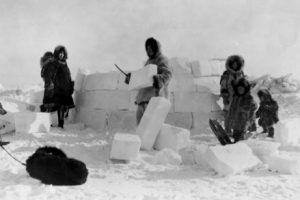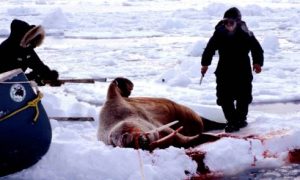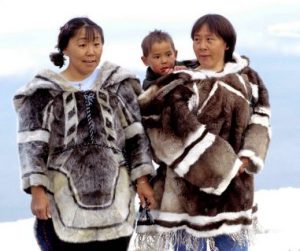Eskimos, also known as Inuit, are a unique group of people, very different from the rest of the world’s population. They are unique because of their lifestyle. Many Inuit, consider the term Eskimo, which is of a disputed etymology to be unacceptable and even pejorative. The governments in Canada and the United States have made moves to cease using the term Eskimo in official documents. Here we will see a summary with all the information about Eskimo for children.
Eskimo for Kids
Table of Contents
What do you remember when you hear the word ‘Eskimos’? A man or a woman or a child in furs that cover from head to toe in a frozen world of snow! The Eskimos are people who live in a land covered with snow.
The Eskimos originated in Alaska, Canada, and Russia. We live in the modern world with growing technology. However, many Eskimos still live as they did in ancient times. Currently, the Eskimos spread throughout Greenland and the northern part of North America. A smaller group of Eskimos live in eastern Siberia.
Approximately, about 80,000 Eskimos live throughout the world.

Origin of the Eskimo
Eskimos share their resemblance to American Indians. In the past, they were called “transformed Indians.” The truth is that the Eskimos evolved from the Mongols, who originated in East Asia. Quite surprisingly, the languages of the Eskimos are not related to any Asian or American countries.
Real Name: Inuit
Although it has become common to refer to the Inuit as Eskimos, this is not their preferred name, nor does it have anything to do with their cultural heritage. Instead, the French or Danes are thought to have first coined the word Eskimo, and it apparently meant “snow people” or “meat eater.” Even many modern Eskimos see the word Eskimo as an insult. Therefore, if you are speaking to someone from an Inuit tribe, make sure to avoid the word Eskimo which could be culturally insensitive. It’s also important to note that Inuit is for plural use, and Inuk is singular.
Most of the history of the Inuit or Eskimos is unknown. Their history was not recorded for many thousands of years. This changed when the Inuit met the Europeans. As far as is known, the Vikings were the first Europeans to encounter the Inuit, in Greenland in 984. In the 18th century, Russian explorers and fur traders began moving into Inuit lands. Once the whaling industry began to grow in the 1700s and 1800s, European traders came into contact with the Inuit. Much of the Inuit culture was destroyed by the large number of European whalers.
Eskimo House
Many believe that the Eskimos or Inuit live in a unique style of house built with snow called an Igloo. This is not entirely correct. The snow house is called an igloo. However, Eskimos do not live in igloos forever. It is a temporary house, built of solid ice blocks with a hole in it. Igloos are the temporary winter homes that provide shelter for Eskimos during their hunting trips.
The permanent houses of the Eskimos are built in the same style as igloos. But these houses are made of wood, seal skin and whale bone. Sealskin is used as a roof, which provides warmth.
Also, during the very brief days of summer, the Eskimos live in houses made of animal skin!
The materials used to build the house change according to the places where they live. Mostly the skin of dead animals and marine animals are used to create shelters.
Mainly through the use of cartoons, people have long thought that Eskimos live in igloos or rounded ice houses to keep warm in the cold climates in which they live. This might have been true originally, but it is not true now.
Today, modern Eskimos live in houses made of wood, stone, and even concrete buildings. They have heating devices that keep them warm in the colder months.
Food of the Eskimo: Inuit Cuisine
Eskimo life was defined by the things around them. They live in a cold environment, mainly near the oceans. Fish is their staple food. They base their food on the meat of snow animals and sea animals. They hardly find fruit or vegetables. Walrus, caribou, seal and polar bears are part of their food.
They eat raw fish and meat cooked in seal oil. Seal oil is also used to heat their houses. They bury seal oil in the ground to keep their homes warm.
There are almost no trees in the Arctic. There are few plants. It is cold most of the year. The Inuit could not become farmers. Like the other people who lived in the Arctic, they were hunters and gatherers. In the short summer, they gathered berries, sea algae sea and eggs. His main source of food was meat.
Vegetarians will find it too difficult to survive if they explore the world of the Eskimos.
Meat-heavy foods are proven to be unhealthy. Surprisingly, the Eskimos, who depend entirely on meats, are still one of the healthiest groups of people in the world!

Inuit Culture and Tradition
Eskimos strictly follow and respect their culture and traditions. They live in groups and respect the leader of the group. They have great respect for women. They work together to survive in the freezing weather conditions. The men are responsible for food and shelter, while the women work to create clothing and cook.
In ancient times, some people, called shamans, were believed to be experts in curing illnesses and had supernatural powers.
While most of the Eskimos living in the modern era in the snow world converted to Christianity, still about 10 percent of the Eskimo population continue to follow their traditional religion.
Eskimo or Inuit Mythology
Inuit mythology is related to the natural wonders of the Arctic. The Aurora Borealis was of particular mystery to the Inuit. Some believed that the faces of the ancestors could be seen dancing within the swirling colors of the lights, while others believed that the lights were deadly. Others saw them as hunting guides, healers, animal souls, or representations of giants. The Inuit peoples relied on shamans to interpret spiritual mysteries. These shamans (called angakkuq) also served as psychologists, healers, and fortune tellers. The Inuit peoples believed that all living things had powerful spirits and that the spirits of animals were the same as those of humans. Therefore, if the spirit of an animal killed in the hunt was not given due respect, the Inuit believed that its spirit could avenge its death.
Eskimo Daily Life
Inuit life was difficult. During the day, they hunted for food. At night, they would build temporary houses made of animal skins, or ice igloos, a skill they learned from the Central Eskimos. They made spears, harpoons and tubes. They carved animals from soft stones. They developed tales and stories. Songs telling stories of hunting and hardship accompanied their stories.
Eskimos Clothing
The Eskimos dressed in clothes made from animal skins. Since the weather was always too cold, there is not much difference in clothing according to gender and age. Eskimos share a great unity by wearing unisex clothing. They wear shoes made of sealskin, which is a waterproof material. Fur clothing, which looks like a long coat, is made from polar bear, fox or caribou. Different parts of the seal were used to make waterproof jackets. Like a kangaroo, an Eskimo mother carries her baby in a bag with her coat.

Inuit: Creative Minds
Eskimos are very creative people. They excel at creating miniature arts like boats, animals, etc. They use animal skins in various ways to create artistic objects. For example, masks, fancy clothes with animal skins, etc.
They enjoy the bitter winter in the Arctic by staying indoors for several days.
In the late 19th and early 20th century, the US government attempted to improve the living conditions of the Inuit. They opened schools and imported reindeer from Siberia so they could hunt again. However, the reindeer population declined after a few years, and the Inuit began to take more stable jobs. Traditional works of art are now a source of income for many Inuit.
Huskies
Dogs were an important part of Inuit culture. Some like Canadian Eskimo Dogs, Alaskan Malamutes or Siberian Hounds were used as pack animals in the summer to pull supplies and to pull sleds in the winter. Such dogs also played an important role in hunting, as they were adept at spotting seal breathing holes or spotting and tracking polar bears. Inuit peoples performed rituals for the birth of new cubs and pricked their noses with pins to improve their sense of smell.